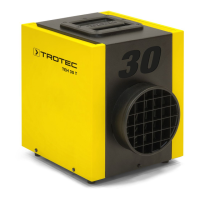Operating manual – Electric heater TEH 20 T / 30 T
EN 4
10. Functions and operation
1
2
3
Switching on the electric heater
Switch the electric heater on by setting the power switch (1) to position
"1". The power switch will flash green and the fan is activated.
Switching off the electric heater
Switch the device off by setting the power switch (1) to position "0".
Caution!
Damage to the device due to overheating.
Do not switch off the device by pulling out the power
cord. This may cause the device to overheat.
Switch off the device properly. Do not disconnect the
power plug before the fan motor has come to a complete
standstill.
Setting the temperature
The temperature of the electric heater can be set by turning the turn
control (3) of the thermostat (on the back of the device) to the desired
position (refer to chapter "Description of device"). The red indicator
lamp (2) starts to flash when the heating process begins.
• Increasing the temperature: Turn the turn control upwards.
• Decreasing the temperature: Turn the turn control downwards.
Adjustments can be made during ongoing operation.
The device is deactivated automatically if the set room temperature is
reached. The indicator lamp (2) goes out.
If the room temperature falls below the set value, heating operation of the
device will be reactivated. The indicator lamp will flash red.
11. Installation and commissioning
Danger!
Risk of injury due to improper operation.
The device may only be used by persons who have been
trained how to operate the device.
For installation and commissioning, proceed as follows:
• Check that the scope of delivery of your electric heater is
complete. If an accessory part is missing, please contact the
Trotec customer service or the specialist dealer from whom you
purchased the device.
• Check the device and its connection parts for possible damage.
Inspect the device prior to each commissioning and check that it
is in proper condition during operation.
Warning!
Risk of injury due to damaged devices.
Do not use any damaged devices or components!
In the case of damage to the electric heater, have it
repaired by a certified special workshop before use.
• Observe the requirements described in chapter "Installation
conditions".
• Ensure that the properties of the applied power connection
comply with the requirements stated on the name plate or in the
chapter "technical data".
• Ensure that the fan can move freely each time before turning on
the device. Small objects in the rotation range of the fan can be
removed with compressed air. In the event of major malfunctions,
always contact a certified specialist workshop. Please observe
the information stated in the chapter "Maintenance and
cleaning". The device must only be disassembled or repaired by
authorised technicians!
• Connect the power supply cable to a properly protected mains
socket (230 V / 50 Hz / 16 A). On construction sites, a residual
current circuit breaker (RCD) must be connected upstream of the
mains socket according to VDE 0100/0105.
The electric heater is now ready for operation. Use the device
according to the functions described in chapter "Functions and
operation".
12. Transport and storage
Transport
• Switch the device off as described in chapter "Functions and
operation".
• Wait until the device has cooled down.
• Transport the electric heater by carrying it with the provided
handle (3).
• During transport by means of a vehicle, protect the device from
vibrations and slipping .
Storage
If the electric heater is not used for a longer period of time, it must be
stored appropriately so that it cannot cause personal injury or property
damage and the device itself cannot become damaged. The following
points are particularly important:
• Always disconnect the device from the power supply.
• The storage location should be as free from dust as possible to
avoid excessive dirtying of the device. Cover the device.
• During storage, the TEH 20 T or 30 T and particularly its electrical
components must be protected from moisture (e. g. snow, rain).
• During storage, the device must be protected from general
climatic conditions (e. g. storm).
• In the case of an elevated storage place, the device must be se-
cured against falling in order to avoid injuries to persons and
damage to the device.

